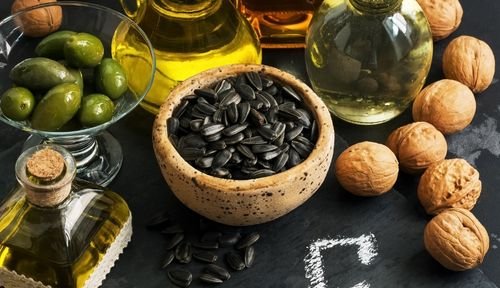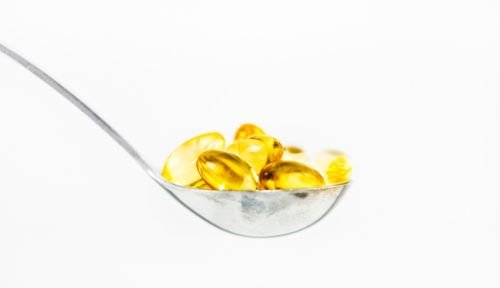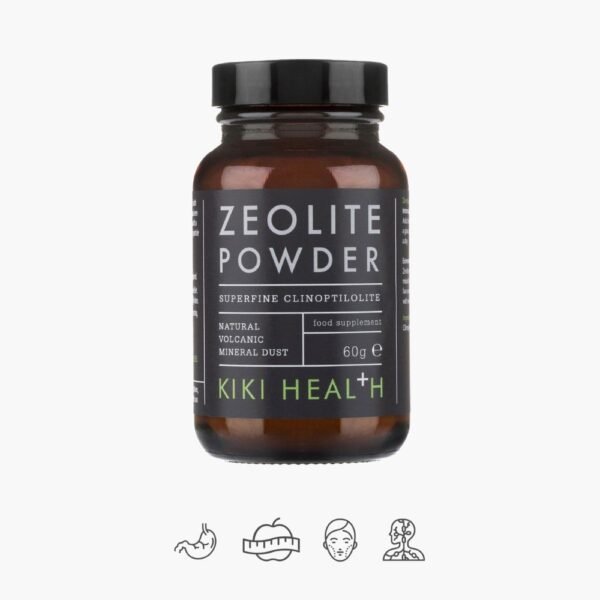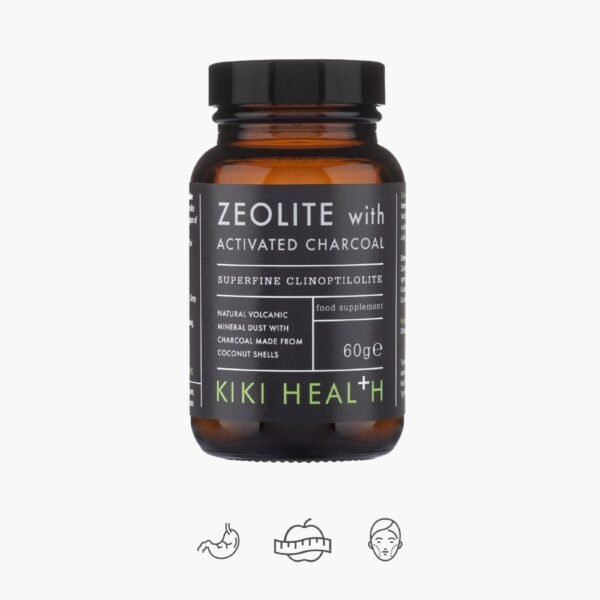Vitamin E is fat soluble vitamin, which has several forms, but alpha-tocopherol is the only form that the human body uses.
The main role of this vitamin is to act as an antioxidant that captures free electrons, the so-called "free radicals", which can damage cells. It also strengthens immune system and prevents the formation of clots in the arteries of the heart.
Antioxidants, including vitamin E, gained public attention in the 1980s, when scientists began to understand that free radical damage is linked to the early stages of arterial-clogging atherosclerosis and may also contribute to vision loss.

What are the forms of vitamin E?
Naturally occurring vitamin E exists in eight chemical forms (alpha, beta, gamma, and delta tocopherol and alpha, beta, gamma, and delta tocotrienol) that have different levels of biological activity. Alpha (or α-) tocopherol is the only form that meets human needs.
The concentration of vitamin E (alpha-tocopherol) depends on the liver, which takes up the nutrient after the various forms are absorbed from the small intestine.
The liver primarily secretes only alpha-tocopherol via the hepatic alpha-tocopherol transporter protein. The liver metabolizes and secretes other forms of vitamin E. As a result, other forms of vitamin E have lower blood and cellular concentrations than alpha-tocopherol and are naturally less studied.
Alpha-tocopherol inhibits the activity of protein kinase C, an enzyme involved in the proliferation and differentiation of smooth muscle cells, platelets and monocytes. Endothelial cells saturated with vitamin E, which line the inner surface of blood vessels, better resist blood cell components adhering to this surface.
Vitamin E also increases the expression of two enzymes that inhibit arachidonic acid metabolism, thereby increasing the release of prostacyclin from the endothelium, which in turn dilates blood vessels and inhibits platelet aggregation.
Recommended doses of Vitamin E
Recommended intakes for vitamin E and other nutrients are provided and vary by age and gender.
Vitamin E recommendations are only for alpha-tocopherol, the only form retained in plasma.
Naturally occurring vitamin E is called RRR-alpha-tocopherol (commonly referred to as d-alpha-tocopherol); the synthetic form is all rac-alpha-tocopherol (commonly referred to as dl-alpha-tocopherol).
The recommended dose of vitamin E is given in milligrams (mg) and is presented in the table below. One mg of vitamin E (alpha-tocopherol) corresponds to 1 mg of RRR-alpha-tocopherol or 2 mg of total rac-alpha-tocopherol. Because there is not enough data to develop an RDA for infants, the levels were developed based on the amount of vitamin E consumed by healthy breastfed infants.
| Table 1. Recommended Dietary Allowances (RDA) for vitamin E (alpha-tocopherol) | ||||
| Age | Men | Women | Pregnancy | When feeding |
| 0-6 months* | 4 mg | 4 mg | ||
| 7-12 months* | 5 mg | 5 mg | ||
| 1-3 years | 6 mg | 6 mg | ||
| 4-8 years | 7 mg | 7 mg | ||
| 9-13 years old | 11 mg | 11 mg | ||
| 14+ years old | 15 mg | 15 mg | 15 mg | 19 mg |

Sources of vitamin E
Food
Many foods contain vitamin E. Nuts, seeds, and vegetable oils are some of the best sources of alpha-tocopherol, and large amounts are found in green leafy vegetables and fortified grains.
| Vitamin E (alpha-tocopherol) content in food products | ||
| Food | Milligrams (mg) per serving | Daily rate in percent |
| Wheat germ oil, 1 tablespoon | 20.3 | 135 |
| Sunflower seeds, dry roasted, 30 g | 7.4 | 49 |
| Almonds, dry roasted, 30 g | 6.8 | 45 |
| Sunflower oil, 1 tablespoon | 5.6 | 37 |
| Safflower oil, 1 tablespoon | 4.6 | 31 |
| Hazelnuts, dry roasted, 30 g | 4.3 | 29 |
| Peanut butter, 2 tbsp | 2.9 | 19 |
| Peanuts, dry roasted, 30 g | 2.2 | 15 |
| Corn oil, 1 tablespoon | 1.9 | 13 |
| Spinach, cooked, ½ cup | 1.9 | 13 |
| Broccoli, chopped, cooked, ½ cup | 1.2 | 8 |
| Soybean oil, 1 tablespoon | 1.1 | 7 |
| Kiwifruit, 1 medium | 1.1 | 7 |
| Mango, sliced, ½ cup | 0.7 | 5 |
| Tomato, green, 1 medium | 0.7 | 5 |
| Spinach, green, 1 cup | 0.6 | 4 |
Foods with 20% or more DN are considered high sources of the nutrient, but foods with lower percentages of DN also contribute to a healthy diet.

Food supplements
Vitamin E supplements usually only provide alpha-tocopherol, although there are "mixed" products that contain other tocopherols and even tocotrienols. In nature, alpha-tocopherol exists in one stereoisomeric form. In contrast, synthetic alpha-tocopherol contains equal amounts of the eight possible stereoisomers. Tissues retain only four of these stereoisomers. Therefore, a certain amount of synthetic alpha-tocopherol (total rac-alpha-tocopherol; usually denoted as "DL" or "dl") is only half the amount (by mg weight) of the natural form (RRR-). alpha-tocopherol; usually marked "D" or "d").
Most supplements containing only vitamin E provide ≥67 mg (100 IU of natural vitamin E) of the nutrient. These amounts are much higher than the RDA.
Alpha-tocopherol, found in dietary supplements and fortified foods, is often esterified to extend its shelf life while retaining its antioxidant properties. These esters (alpha-tocopheryl acetate and succinate) are hydrolyzed and absorbed by the body as efficiently as alpha-tocopherol.
Low-fat diets may not provide enough vitamin E unless people make careful food choices, such as increasing nuts, seeds, fruits, and vegetables.
Vitamin E deficiency
Very low birth weight (<1500 grams) premature babies may be deficient in vitamin E. Vitamin E supplements may reduce the risk of some complications such as damage to the retina in these babies, but they may also increase the risk of infections.
Because the digestive tract needs fat to absorb vitamin E, people with fat malabsorption disorders are more likely to be deficient than people without such disorders. Deficiency symptoms include:
- peripheral neuropathy,
- ataxia,
- skeletal myopathy,
- retinopathy,
- immune response disorder,
For example, people with Crohn's disease, cystic fibrosis, or the inability to secrete bile from the liver into the digestive tract often have oily stools or chronic diarrhea. Because of this, they sometimes need water-soluble forms of vitamin E.
Some people with abetalipoproteinemia, a rare inherited disorder that causes poor absorption of dietary fat, need extra doses of vitamin E (about 100 mg/kg or 5-10 g per day).
Vitamin E deficiency due to abetalipoproteinemia causes problems such as:
- poor transmission of nerve impulses,
- muscle weakness
- retinal degeneration leading to blindness.
Ataxia and vitamin E deficiency is another rare inherited disorder in which the hepatic alpha-tocopherol transport protein is defective or absent. People are so deficient in vitamin E that they experience nerve damage and lose the ability to walk unless they take large supplemental doses of vitamin E.

Vitamin E and health
Many claims have been made about vitamin E's potential to promote health and prevent and treat disease. Vitamin E can provide protection by acting as an antioxidant or actively participating in anti-inflammatory processes, inhibition of platelet aggregation and strengthening of immunity.
This chapter focuses on four diseases and disorders linked to vitamin E: heart disease, cancer, eye disorders, and cognitive decline.
Coronary heart disease and Vitamin E
Vitamin E can help prevent or slow coronary heart disease. Studies have shown that the nutrient inhibits the oxidation of low-density lipoprotein (LDL) cholesterol, which is an essential initial step in atherosclerosis. Vitamin E can also help prevent blood clots that can lead to a heart attack or venous thromboembolism.
Several studies have linked lower rates of heart disease to higher intakes of vitamin E. One study of approximately 90,000 nurses found that the incidence of heart disease was 30 to 40 % lower in those with the highest intake of vitamin E, primarily from dietary supplements. Among 5,133 Finnish men and women who were followed for an average of 14 years, higher dietary vitamin E intake was associated with reduced mortality.
In the most recently published clinical trial on the cardiovascular effects of vitamin E in women, nearly 40,000 healthy women ≥ 45 years of age were randomized to receive 600 IU natural vitamin E (402 mg) on alternate days or placebo and were followed for an average of 10 years [25]. The study showed two positive and significant results for women taking vitamin E: a 24 percent reduction in cardiovascular disease mortality and a 26 percent reduction in those over 65. fewer fatal heart attacks and 49 percent mortality from cardiovascular diseases.

Cancer may not like vitamin E
Antioxidant nutrients such as vitamin E protect cellular components from the damaging effects of free radicals, which, if left unchecked, can contribute to the development of cancer.
Vitamin E can also block the formation of carcinogenic nitrosamines produced in the stomach from nitrites in foods and protect against cancer by boosting immune function.
Among current smokers and male quitters, vitamin E intake greater than 400 IU/day (form not specified) was associated with a statistically significant 71% advanced prostate by reducing the risk of cancer.
In a clinical trial of 29,133 male smokers, men randomly assigned to take 111 IU of synthetic vitamin E (50 mg, as dl-alpha-tocopheryl acetate) daily for 5 to 8 years had 32 % fewer prostate cancers compared with subjects who did not take supplements [30].
One study of women in Iowa found that higher intakes of vitamin E through food and supplements may reduce the risk of colon cancer, especially in women younger than 65.33].
The American Cancer Society conducted an epidemiological study examining the relationship between vitamin C and vitamin E supplement use and bladder cancer mortality. Among nearly one million adults followed between 1982 and 1998, adults who took vitamin E for 10 years or more had a reduced risk of dying from bladder cancer.36]
Eye disorders
Age-related macular degeneration and cataracts are among the most common causes of vision loss in older adults. Their etiology is generally unknown, but cumulative effects of oxidative stress are thought to play a role.
Nutrients with antioxidant functions, such as vitamin E, can be used to prevent or treat these conditions.
Prospective cohort studies have shown that people with adequate vitamin E intake (eg, 20 mg/day [30 IU]) have an approximately 20 % lower risk of developing the disease than people with low vitamin E intake (eg, <10 mg per day).
The Age-Related Eye Disease Study (AREDS), a large randomized clinical trial, showed that participants at high risk of developing advanced AMD (that is, those with moderate AMD or advanced AMD in one eye) had a reduced risk of developing advanced AMD 25 %, taking a daily supplement containing vitamin E (400 IU [180 mg] dl-alpha-tocopheryl acetate), beta-carotene (15 mg), vitamin C (500 mg), zinc (80 mg) and copper ( 2 mg) compared to participants taking placebo for more than 5 years [41].
Several observational studies have found an association between vitamin E supplementation and risk of cataract formation. One prospective cohort study found that lens clarity was better in those who took vitamin E supplements and those with higher blood levels of the vitamin.
Another study found that long-term vitamin E supplementation was associated with slower progression of age-related lens opacities.44].
Cognitive decline
The brain has a high rate of oxygen consumption and is high in polyunsaturates fat acidic in neuronal cell membranes. If cumulative free radical damage to neurons over time contributes to cognitive decline and neurodegenerative diseases such as Alzheimer's disease, then adequate or supplemental intake of antioxidants (such as vitamin E) may provide some protection.47].
This was confirmed by the results of a clinical trial in which 341 patients with moderate Alzheimer's disease were randomly assigned to placebo, vitamin E (2000 IU per day dl-alpha-tocopherol), monoamine oxidase inhibitor (selegiline). or vitamin E and selegiline [47]. Over 2 years, treatment with vitamin E and selegiline, alone or in combination, significantly delayed functional decline and the need for institutionalization compared with placebo.
Health risks of excess vitamin E
Studies have found no adverse effects of dietary vitamin E intake. However, high doses of alpha-tocopherol supplements can cause bleeding and interfere with blood clotting.
Data also show that high doses inhibit platelet aggregation. Two clinical trials found an increased risk of hemorrhagic stroke in participants taking alpha-tocopherol.
Long-term consumption above the UL increases the risk of adverse health effects.
| Tolerable Upper Intake Levels (UL) for Vitamin E | ||||
| Age | A man | A woman | Pregnancy | When feeding |
| 1-3 years | 200 mg | 200 mg | ||
| 4-8 years | 300 mg | 300 mg | ||
| 9-13 years old | 600 mg | 600 mg | ||
| 14-18 years old | 800 mg | 800 mg | 800 mg | 800 mg |
| 19+ years old | 1000 mg | 1000 mg | 1000 mg | 1000 mg |
Drug interactions of vitamin E
Vitamin E supplements can interact with several types of medications. Below are some examples. People taking these and other medications regularly should discuss vitamin E intake with their health care professional.
Anticoagulants and antiplatelet drugs
Vitamin E can inhibit platelet aggregation and antagonize vitamin K-dependent coagulation factors. As a result, high-dose use with anticoagulants or antiplatelet drugs such as warfarin (Coumadin®) may increase the risk of bleeding, especially with low vitamin K intake. day.61].
Simvastatin and niacin
Some people take vitamin E supplements with other antioxidants, such as vitamin C, selenium, and beta-carotene. This collection of antioxidant ingredients reduced high-density lipoprotein (HDL) cholesterol, especially HDL2, the most cardioprotective component of HDL, in people treated with a combination of simvastatin (trade name Zocor®) and niacin.62,63].
Chemotherapy and radiotherapy
Oncologists generally advise against the use of antioxidant supplements during cancer chemotherapy or radiation therapy, as they may reduce the effectiveness of these treatments by inhibiting cellular oxidative damage to cancer cells.64,65]. Although a systematic review of randomized controlled trials questioned this concern [66], further research is needed to assess the potential risks and benefits of combining antioxidant supplementation with conventional cancer treatments.
Vitamin E and a healthy diet
Because food provides many nutrients and other health-promoting components, nutritional needs should be met primarily through food. In some cases, fortified foods and nutritional supplements are useful when one or more nutrient requirements cannot be met otherwise (eg, during certain stages of life, such as pregnancy).
The Dietary Guidelines define a healthy eating pattern as one that:
- Includes a variety of vegetables; fruits; cereals (at least half whole grains); low-fat and low-fat milk, yogurt and cheese; and oils.
Vitamin E is found in green leafy vegetables, whole grains, fortified grains and vegetable oils.
- Include a variety of protein foods, such as lean meats; poultry; eggs; seafood; beans, peas and lentils; nuts and seeds; and soy products.
Nuts are a good source of vitamin E.
- Limit foods and beverages high in added sugar, saturated fat, and sodium.
- Limits the consumption of alcoholic beverages.
- Do not exceed your daily calorie needs.











